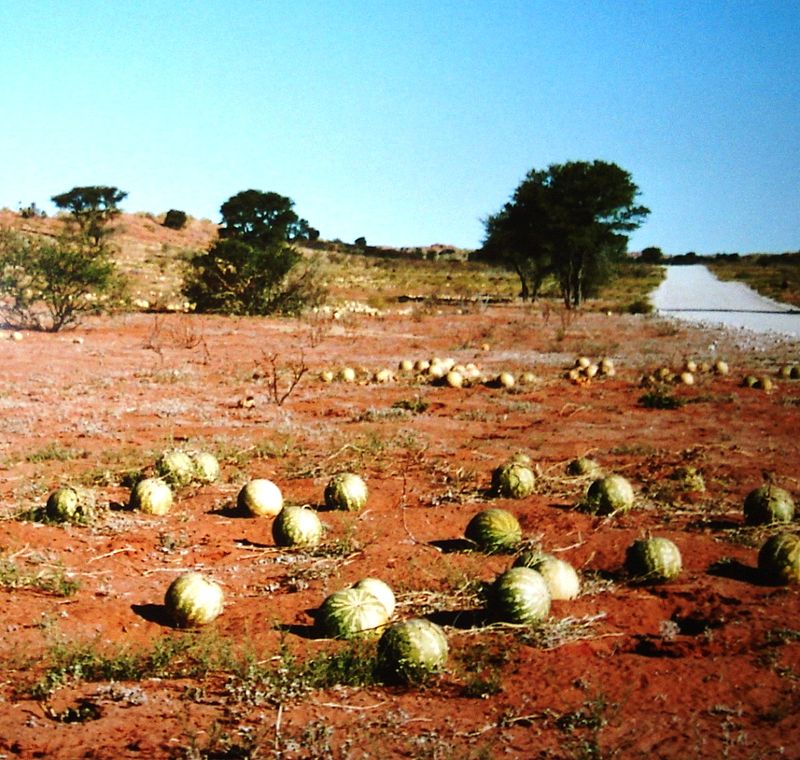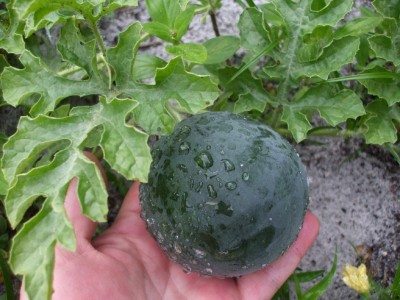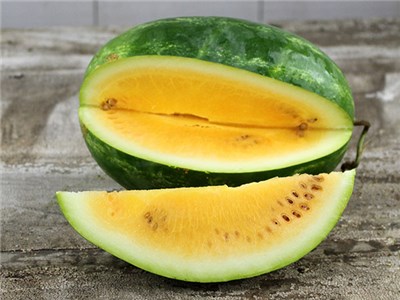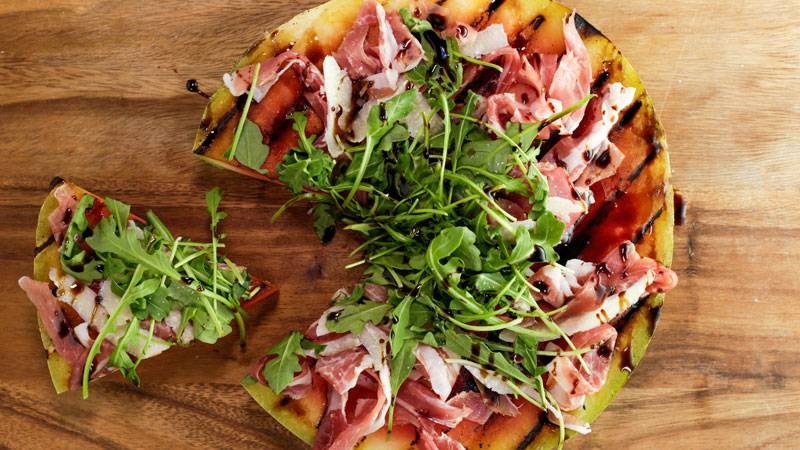 Whether you’re finding watermelon in the tombs of ancient pharaohs or piled on picnic tables, one thing is for sure: the summer staple is here to stay.
Whether you’re finding watermelon in the tombs of ancient pharaohs or piled on picnic tables, one thing is for sure: the summer staple is here to stay.
The first traces of watermelon were found in sub-Saharan Africa, dating to roughly 5,000 years ago. The scrambling, trailing vine bore unappetizing fruit, often bitter or bland. Varieties of the flowering plant spread across northeast Africa, and were eventually cultivated in Egypt in the Nile valley around 2000 B.C. Hieroglyphs of harvesting activity can be found in Egyptian tombs dating to the Twelfth Dynasty in Egypt, and the seeds of ancient strains of watermelon have been found in the tombs of pharaohs, including the famous Tutankhamun – indications that the fruit was even given as a gift to royalty in the afterlife.
 The original watermelons were far from the same delectable fruit we think of today, but it was the Egyptians who began selectively breeding watermelon to achieve its palatable flavor. Beyond just tasting good, the Egyptians discovered other advantages to watermelon. True to its modern name, the juicy flesh of the fruit was able to store substantial amounts of water and had a long lasting “shelf life” compared to other fruits. The watermelon was cherished during the dry season for these reasons.
The original watermelons were far from the same delectable fruit we think of today, but it was the Egyptians who began selectively breeding watermelon to achieve its palatable flavor. Beyond just tasting good, the Egyptians discovered other advantages to watermelon. True to its modern name, the juicy flesh of the fruit was able to store substantial amounts of water and had a long lasting “shelf life” compared to other fruits. The watermelon was cherished during the dry season for these reasons.
The watermelon later could be found in Europe, where it thrived in areas such as the Mediterranean. Later it was grown in India, China and eventually brought to America by European colonists. As both a natural canteen and desirable fruit, the watermelon made for a popular trade item and useful cargo on long voyages.
 Watermelon now takes on many different shapes, sizes and colors. Today, there are over 1,200 different varieties of watermelon, and these newbies can have different colored rind and flesh, various sugar contents and range in size from a “personal melon” to 200-pound village feeding fruit.
Watermelon now takes on many different shapes, sizes and colors. Today, there are over 1,200 different varieties of watermelon, and these newbies can have different colored rind and flesh, various sugar contents and range in size from a “personal melon” to 200-pound village feeding fruit.
To keep things simple, there are four basic types: seedless, picnic, icebox and yellow/orange. The more uncommon features are found in the icebox and yellow/orange varieties. The icebox watermelon is basically individual, seedless and picnic watermelons. The ‘baby’ varieties are 5-15 pounds, and can often fit in the palm of your hand. The yellow/orange watermelons refer to the color of the inner flesh of the melon.
 Watermelon has been a popular fruit throughout history, and in all that time people have found endless ways to enjoy it. Today, you’ll find everything from grilled watermelon pizza to watermelon granite, watermelon jerky to pickled rinds — you have not seen it all when it comes to watermelon. Whether you enjoy your watermelon in classic triangle pieces or with feta and blackberries on a skewer, it will continue to be a quintessential slice of summer.
Watermelon has been a popular fruit throughout history, and in all that time people have found endless ways to enjoy it. Today, you’ll find everything from grilled watermelon pizza to watermelon granite, watermelon jerky to pickled rinds — you have not seen it all when it comes to watermelon. Whether you enjoy your watermelon in classic triangle pieces or with feta and blackberries on a skewer, it will continue to be a quintessential slice of summer.
Related Stories
‹

CHCCS Summer Food Program Shares Locations, Start TimesSince being founded in 2015, the Chapel Hill-Carrboro City Schools and Town of Chapel Hill summer food program has served hundreds of thousands of meals during the gap between academic years. Starting next week, the program will be back and feeding even more local students. The CHCCS district announced its Food for Students program will […]

Howdy Hillsborough: Episode 2 - Wine & SummerThis week on "Howdy Hillsborough," Eryk and Alexis are joined by Sam Otterbourg from Chapel Hill & Hillsborough Wine Company.

Just the Bill, Please: Eating Out of the GardenIt’s hot as blazes and everything is out of whack, so I thought this time, why not indulge ourselves with something pleasant for a change? A momentary distraction. Something reliable and familiar. “Eating out of the garden,” a phrase I grew up with down East, came to mind. It’s high summer in North Carolina — […]

Just The Bill, Please: Changing Times & Blackberry BushesIt’s mid-summer and, remarkably, all of those crazy changes that we had to face so suddenly this winter have become routine. Even though there is talk of reopening and returning to normal, it’s clear that in the backs of their minds, at least, lots of people aren’t buying it. Talk of an awful second wave […]

Commandments of Style: How to Wear White PantsTop 3 Looks – How to Wear White Pants White Pants. Scary, right? It doesn’t have to be. Easily paired with any color, white pants are fantastic for summer in formal or casual settings. Here are three easy ways to wear them and make them seamlessly work with your wardrobe. You can also pair with a navy polo […]

Commandments of Style: How to Wear Dark Denim and a BlazerTop 3 Looks – How to Wear Dark Denim and a Blazer For most guys, you could easily get away with just one pair of jeans. They should be a pair of dark denim in a straight fit. The cuff of the jeans should hit just past the top of your shoes, so there is […]

Commandments of Style: How to Wear a Khaki SuitThe khaki suit: a summer staple, a warm-weather fashion icon. There are so many different shades and varying fits to choose from that it seems you can’t go wrong, but the khaki suit is not to be underestimated. If not worn properly, khaki can quickly shift from classic to outdated. When shopping for a khaki […]

Commandments of Style: 5 Picks for Summer ShoesWarmer weather means it’s time to update your selection of shoes accordingly. In today’s “Commandments of Style,” we’ll be taking a look at my top five picks for shoes to add to your wardrobe this summer. Shoes are an essential part of your style to never skimp on. They can make or break an outfit, […]

Now Beer This: Beers By The PoolYou might love the pool, like the pool or merely tolerate the pool for your kids’ sake. Either way, we can probably agree on one thing: beer by the pool only makes the experience better. The right pool beer can be a rousing brew that takes a summer party from a 9 to a 10, […]
![]()
Food for the Summer Program Comes to a CloseThis Friday marks the end of this year’s Food for the Summer program, which provides free lunches for children at different meal sites in Chapel Hill and Carrboro while school is out. This summer through July 28, Chapel Hill Carrboro City School cafeterias have provided almost 40,000 total meals for children, serving several dozens of […]
›
 Whether you’re finding watermelon in the tombs of ancient pharaohs or piled on picnic tables, one thing is for sure: the summer staple is here to stay.
Whether you’re finding watermelon in the tombs of ancient pharaohs or piled on picnic tables, one thing is for sure: the summer staple is here to stay. The original watermelons were far from the same delectable fruit we think of today, but it was the Egyptians who began selectively breeding watermelon to achieve its palatable flavor. Beyond just tasting good, the Egyptians discovered other advantages to watermelon. True to its modern name, the juicy flesh of the fruit was able to store substantial amounts of water and had a long lasting “shelf life” compared to other fruits. The watermelon was cherished during the dry season for these reasons.
The original watermelons were far from the same delectable fruit we think of today, but it was the Egyptians who began selectively breeding watermelon to achieve its palatable flavor. Beyond just tasting good, the Egyptians discovered other advantages to watermelon. True to its modern name, the juicy flesh of the fruit was able to store substantial amounts of water and had a long lasting “shelf life” compared to other fruits. The watermelon was cherished during the dry season for these reasons. Watermelon now takes on many different shapes, sizes and colors. Today, there are over 1,200 different varieties of watermelon, and these newbies can have different colored rind and flesh, various sugar contents and range in size from a “personal melon” to 200-pound village feeding fruit.
Watermelon now takes on many different shapes, sizes and colors. Today, there are over 1,200 different varieties of watermelon, and these newbies can have different colored rind and flesh, various sugar contents and range in size from a “personal melon” to 200-pound village feeding fruit. Watermelon has been a popular fruit throughout history, and in all that time people have found endless ways to enjoy it. Today, you’ll find everything from grilled watermelon pizza to watermelon granite, watermelon jerky to pickled rinds — you have not seen it all when it comes to watermelon. Whether you enjoy your watermelon in classic triangle pieces or with feta and blackberries on a skewer, it will continue to be a quintessential slice of summer.
Watermelon has been a popular fruit throughout history, and in all that time people have found endless ways to enjoy it. Today, you’ll find everything from grilled watermelon pizza to watermelon granite, watermelon jerky to pickled rinds — you have not seen it all when it comes to watermelon. Whether you enjoy your watermelon in classic triangle pieces or with feta and blackberries on a skewer, it will continue to be a quintessential slice of summer.









